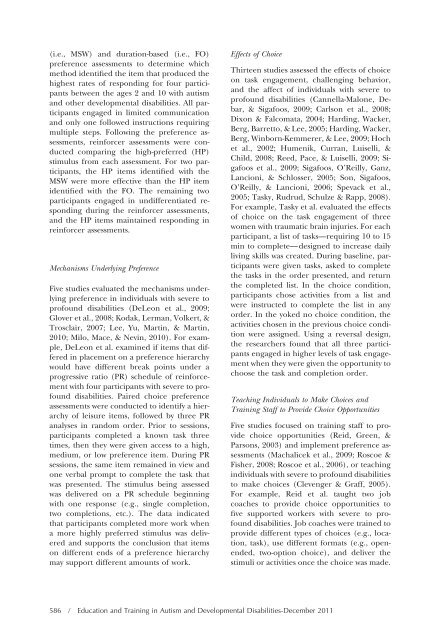etadd_46(4) - Division on Autism and Developmental Disabilities
etadd_46(4) - Division on Autism and Developmental Disabilities
etadd_46(4) - Division on Autism and Developmental Disabilities
You also want an ePaper? Increase the reach of your titles
YUMPU automatically turns print PDFs into web optimized ePapers that Google loves.
(i.e., MSW) <strong>and</strong> durati<strong>on</strong>-based (i.e., FO)<br />
preference assessments to determine which<br />
method identified the item that produced the<br />
highest rates of resp<strong>on</strong>ding for four participants<br />
between the ages 2 <strong>and</strong> 10 with autism<br />
<strong>and</strong> other developmental disabilities. All participants<br />
engaged in limited communicati<strong>on</strong><br />
<strong>and</strong> <strong>on</strong>ly <strong>on</strong>e followed instructi<strong>on</strong>s requiring<br />
multiple steps. Following the preference assessments,<br />
reinforcer assessments were c<strong>on</strong>ducted<br />
comparing the high-preferred (HP)<br />
stimulus from each assessment. For two participants,<br />
the HP items identified with the<br />
MSW were more effective than the HP item<br />
identified with the FO. The remaining two<br />
participants engaged in undifferentiated resp<strong>on</strong>ding<br />
during the reinforcer assessments,<br />
<strong>and</strong> the HP items maintained resp<strong>on</strong>ding in<br />
reinforcer assessments.<br />
Mechanisms Underlying Preference<br />
Five studies evaluated the mechanisms underlying<br />
preference in individuals with severe to<br />
profound disabilities (DeLe<strong>on</strong> et al., 2009;<br />
Glover et al., 2008; Kodak, Lerman, Volkert, &<br />
Trosclair, 2007; Lee, Yu, Martin, & Martin,<br />
2010; Milo, Mace, & Nevin, 2010). For example,<br />
DeLe<strong>on</strong> et al. examined if items that differed<br />
in placement <strong>on</strong> a preference hierarchy<br />
would have different break points under a<br />
progressive ratio (PR) schedule of reinforcement<br />
with four participants with severe to profound<br />
disabilities. Paired choice preference<br />
assessments were c<strong>on</strong>ducted to identify a hierarchy<br />
of leisure items, followed by three PR<br />
analyses in r<strong>and</strong>om order. Prior to sessi<strong>on</strong>s,<br />
participants completed a known task three<br />
times, then they were given access to a high,<br />
medium, or low preference item. During PR<br />
sessi<strong>on</strong>s, the same item remained in view <strong>and</strong><br />
<strong>on</strong>e verbal prompt to complete the task that<br />
was presented. The stimulus being assessed<br />
was delivered <strong>on</strong> a PR schedule beginning<br />
with <strong>on</strong>e resp<strong>on</strong>se (e.g., single completi<strong>on</strong>,<br />
two completi<strong>on</strong>s, etc.). The data indicated<br />
that participants completed more work when<br />
a more highly preferred stimulus was delivered<br />
<strong>and</strong> supports the c<strong>on</strong>clusi<strong>on</strong> that items<br />
<strong>on</strong> different ends of a preference hierarchy<br />
may support different amounts of work.<br />
Effects of Choice<br />
Thirteen studies assessed the effects of choice<br />
<strong>on</strong> task engagement, challenging behavior,<br />
<strong>and</strong> the affect of individuals with severe to<br />
profound disabilities (Cannella-Mal<strong>on</strong>e, Debar,<br />
& Sigafoos, 2009; Carls<strong>on</strong> et al., 2008;<br />
Dix<strong>on</strong> & Falcomata, 2004; Harding, Wacker,<br />
Berg, Barretto, & Lee, 2005; Harding, Wacker,<br />
Berg, Winborn-Kemmerer, & Lee, 2009; Hoch<br />
et al., 2002; Humenik, Curran, Luiselli, &<br />
Child, 2008; Reed, Pace, & Luiselli, 2009; Sigafoos<br />
et al., 2009; Sigafoos, O’Reilly, Ganz,<br />
Lanci<strong>on</strong>i, & Schlosser, 2005; S<strong>on</strong>, Sigafoos,<br />
O’Reilly, & Lanci<strong>on</strong>i, 2006; Spevack et al.,<br />
2005; Tasky, Rudrud, Schulze & Rapp, 2008).<br />
For example, Tasky et al. evaluated the effects<br />
of choice <strong>on</strong> the task engagement of three<br />
women with traumatic brain injuries. For each<br />
participant, a list of tasks—requiring 10 to 15<br />
min to complete—designed to increase daily<br />
living skills was created. During baseline, participants<br />
were given tasks, asked to complete<br />
the tasks in the order presented, <strong>and</strong> return<br />
the completed list. In the choice c<strong>on</strong>diti<strong>on</strong>,<br />
participants chose activities from a list <strong>and</strong><br />
were instructed to complete the list in any<br />
order. In the yoked no choice c<strong>on</strong>diti<strong>on</strong>, the<br />
activities chosen in the previous choice c<strong>on</strong>diti<strong>on</strong><br />
were assigned. Using a reversal design,<br />
the researchers found that all three participants<br />
engaged in higher levels of task engagement<br />
when they were given the opportunity to<br />
choose the task <strong>and</strong> completi<strong>on</strong> order.<br />
Teaching Individuals to Make Choices <strong>and</strong><br />
Training Staff to Provide Choice Opportunities<br />
Five studies focused <strong>on</strong> training staff to provide<br />
choice opportunities (Reid, Green, &<br />
Pars<strong>on</strong>s, 2003) <strong>and</strong> implement preference assessments<br />
(Machalicek et al., 2009; Roscoe &<br />
Fisher, 2008; Roscoe et al., 2006), or teaching<br />
individuals with severe to profound disabilities<br />
to make choices (Clevenger & Graff, 2005).<br />
For example, Reid et al. taught two job<br />
coaches to provide choice opportunities to<br />
five supported workers with severe to profound<br />
disabilities. Job coaches were trained to<br />
provide different types of choices (e.g., locati<strong>on</strong>,<br />
task), use different formats (e.g., openended,<br />
two-opti<strong>on</strong> choice), <strong>and</strong> deliver the<br />
stimuli or activities <strong>on</strong>ce the choice was made.<br />
586 / Educati<strong>on</strong> <strong>and</strong> Training in <strong>Autism</strong> <strong>and</strong> <strong>Developmental</strong> <strong>Disabilities</strong>-December 2011
















